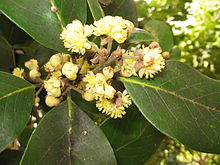Laurus azorica
| Laurus azorica | |
|---|---|

| |
| Scientific classification | |
| Kingdom: | Plantae |
| Clade: | Tracheophytes |
| Clade: | Angiosperms |
| Clade: | Magnoliids |
| Order: | Laurales |
| Family: | Lauraceae |
| Genus: | Laurus |
| Species: | L. azorica
|
| Binomial name | |
| Laurus azorica (Seub.) Franco
| |
| Synonyms[3][4] | |
| |
Laurus azorica, the Azores laurel or Macaronesian laurel, is a small, evergreen tree in the laurel family (Lauraceae), found only on the Azores island group in the North Atlantic.
Description
[edit]The Azores laurel is a small dioecious tree, growing up to 15 m (49 ft) in height.[2] Each flower is fragrant, creamy white, about 1 cm diameter, and they are borne in pairs beside a leaf. The leaves are large, shiny dark green, broadly ovoid, 7–14 cm long and 4–8 cm broad, with an entire margin. The fruit is a black drupe about 1–2 cm long.[citation needed]
Distribution and habitat
[edit]Laurus azorica is native to the Azores, where it is found in all of the islands. It is a major component of the laurisilva and high altitude juniper forests, occasionally with Myrica faya and Picconia azorica populations in mid-altitude. It is also found in lava flows, margins of cultivated land, coastal scrubland, mountain scrubland and forested peat bogs.[2][5]
Taxonomy
[edit]As the result of a recent taxonomic change, Laurus azorica is now restricted to the archipelago of the Azores, whereas former populations of this species from the western Canary islands including Gran Canaria and from the Madeira archipelago have been described as a new species, Laurus novocanariensis.
References
[edit]- ^ Paulina, Kondraskov; Marcus, Koch; Mike, Thiv. "How did Lauraceae colonise Macaronesia?". Retrieved 21 March 2022.
- ^ a b c Silva, L.; Beech, E. (2017). "Laurus azorica". IUCN Red List of Threatened Species. 2017: e.T38397A81868030. doi:10.2305/IUCN.UK.2017-3.RLTS.T38397A81868030.en. Retrieved 16 November 2021.
- ^ "The Plant List: A Working List of all Plant Species".
- ^ "Laurus azorica (Seub.) Franco | Plants of the World Online | Kew Science". Plants of the World Online. Retrieved 4 February 2022.
- ^ "Laurus azorica (Seub.) Franco". Flora-on. Retrieved 11 December 2020.




